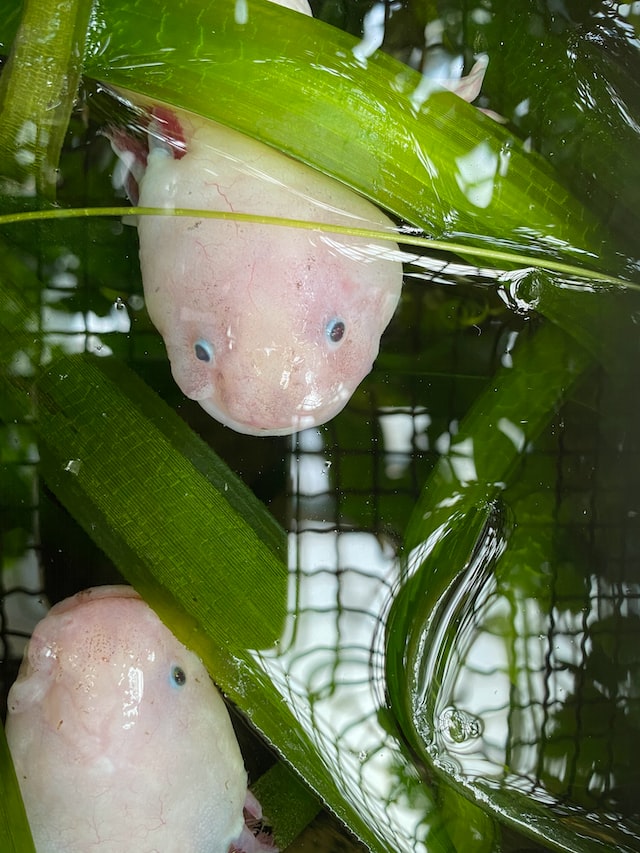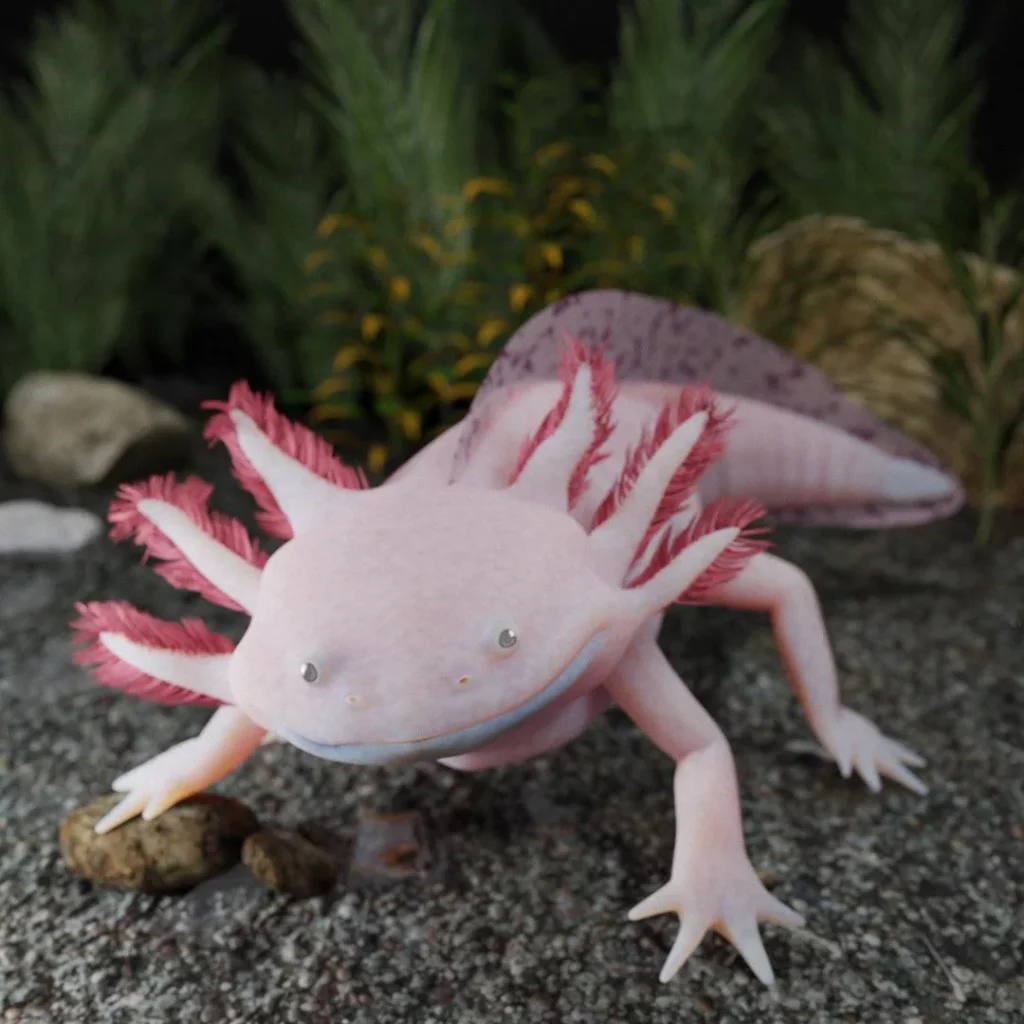24 Interesting Axolotl Facts for Kids [2024 Updated]
The axolotl is a neotenic amphibian species indigenous to Lake Xochimilco, its canal systems, and a few nearby rivers in Mexico City. It is closely related to the Ambystoma tigrinum, also known as the tiger salamander. The axolotl rarely develops into a terrestrially adapted animal, in contrast to its relative; instead, it retains several characteristics of its larval stage into maturity, including external gills and a paddle-like fin bordering the dorsum and tail.

In this article, we will be sharing some interesting facts about axolotl for kids to learn more about these exciting creatures!
Basic facts about axolotl:
Length
Some axolotls are said to grow to a total length of 30–40 cm (12–15 in); however, most specimens only grow to 23–25 cm, making them giant salamanders (9-10 in).
Physical appearance
Both the male and female Mexican walking fish are simple to recognize. The male’s eyes lack eyelids, and his skull is huge and broad. Their tail is also longer than the female’s and has a papilla-lined, enlarged cloaca. The cloaca is smaller in females with rounded, swollen bodies. Four pigmentation genes, which can create various color changes during mutation, are present in both male and female axolotls. It is usual to discover these aquatic critters in albino form because of their transparent skin.

Weight
Males typically weigh 130 grams, whereas the average female weight is 180 grams. It is an amphibian, not a fish, sometimes referred to as the “Mexican Walking Fish.” Freshwater lakes and ponds in Mexico are home to axolotl. The female is typically, but not always, shorter in length than the male.
Food
They prey primarily on tiny fish, mollusks, and arthropod species, as well as other aquatic life that is smaller in size. They can change their diet to include zooplankton, terrestrial worms, salmon eggs, and other freshwater organisms.
The axolotl suction feeds rather than chewing its food. Rakers that interlock and seal the gill openings as food is pulled into the mouth are used to do this. They consume meat and will consume tiny fish, insects, and worms.

They’ll consume almost anything they can get, including fish, worms, mollusks, and even insects that float on the water’s surface. They are preyed upon by birds and invasive species like perch and tilapia.
Breathing
Axolotls can breathe air. Because they lack lungs, axolotls breathe as many amphibians do through their gills. However, the gills of axolotls are pretty important as they enable them to exchange bodily gasses and transport beneficial gasses.
Axolotls can breathe air using their gills, which only function for a short while outside the water. Keeping your happy dogs deprived of water for an extended time is, therefore, not advised. Thus, the gas exchange in axolotls occurs most frequently in water, where the gills are located on the head’s right, left, and top sides.
Unlike many fish, axolotls can remain stationary, fanning their feathery gills to force oxygen into the capillaries. Fish must, however, move about to breathe air through their gills. Remember that an axolotl’s gills should flap slowly and consistently when it’s comfortable and healthy; otherwise, there may be a problem. The axolotl’s gills may be diseased, or the animal may have general breathing difficulties if it flutters quickly and inconsistently.
Movement
As exclusively aquatic creatures, axolotls live their entire lives in water. They can, however, stay out of the water for a short while because they can breathe air, but they cannot go without water for an extended period. Since everyone knows axolotls have legs, you could assume they can move about on land, but they cannot traverse the land.

They may become semi-aquatic creatures during winters and acclimate to the land. Additionally, male axolotls attach their tail to their bodies during breeding and walk on water’s surface using only their legs. However, they have never been observed traversing the terrain.
Fun Axolotls facts for kids:
The name “Axolotl” is of strange origin.
The word “axolotl,” which translates to “water dog,” comes from the Ancient Aztecs who venerated these creatures. The legendary Xolotl, an Aztec god with a dog head, relates to the axolotl. The god of fire, lightning, disfigurement, and death was known as Xolotl.
The Aztec gods were said to have had to sacrifice the sun to keep it alive and travel through the sky. Xolotl first became a maguey plant to avoid being sacrificed before changing back into an Axolotl.
Also Read: Seahorse Facts
Axolotls don’t undergo metamorphosis.
The way that this amphibian matures is what distinguishes it as being so odd. It does not go through metamorphosis, a process whereby amphibians generally acquire lungs and legs and learn to walk on land. The axolotl keeps the traits it develops during the larval stage, including its gills and aquatic life. Its gills are the branches that project from either side of its head and have a fluffy appearance.

Axolotls are resistant to cancer.
Additionally, compared to mammals, axolotls are almost 1,000 times more resistant to cancer. In the future, researchers plan to use the axolotl’s innate resistance to combat cancer and lengthen human life.
Axolotls can regrow their limbs.
Axolotls have a remarkable capacity for regenerating missing limbs and internal organs. Amazingly, an Axolotl can regrow missing limbs in a few weeks. If it sustains a head injury and recovers without any scarring, it can rebuild its lungs, heart, and portions of its brain. A protein known as c-Fos is essential for the regeneration process. Up to five times can an axolotl recover the same limb. Then comes a halt. By the sixth time, researchers found that few limbs could regenerate to their full potential and that scar tissue instead began to form.
Axolotls eat gravel with food to control buoyancy.
The axolotl, a bottom feeder, effectively uses gravel drawn up with food. The little water creatures that the axolotl sucks into its mouth while feeding is frequently mixed with gravel. This, however, is not a negative thing. Like how birds use grit to assist break up food for digestion, fish will use the eaten gravel to produce a grinding motion on food. Additionally, the Mexican Walking Fish controls buoyancy with gravel inside its body.
Also Read: Starfish Facts
Axolotls waltz before breeding.
The waltz is the first step in breeding for the male and female axolotl. In essence, it is a dance that the two of them do that marks the beginning of mating. The male and female will dance in a circular motion while rubbing and sliding across each other’s cloaca.

Eventually, the male will expel a cone-shaped mass covered in sperm. He shakes his tail vigorously for about thirty seconds before doing this. After a tail-shaking display, the female will pick up the deposit with her cloaca, and fertilization will start.
Females lay an enormous number of eggs.
The female axolotls lay an enormous number of eggs, between 300 and 1,000, in the water. Each is fastened to a shielding material. Individually deposited eggs are frequently positioned on vegetation or rocks to shield them from predators. The eggs hatch in two weeks, and as soon as the young axolotls emerge from their eggs, they are on their own.
Currently, Axolotls are only found in Mexico City’s Lake Xochimilco.
Originally, axolotls inhabited several lakes and wetlands in central Mexico. Currently, they can only be found in Mexico City’s Lake Xochimilco.

Their habitat is getting smaller.
Its population has significantly decreased as a result of many circumstances. Invasive fish species have been the main issue. These non-native fish compete with axolotls for food in the ecosystem. Axolotls are also eaten by invading fish. The habitat of axolotls has been getting smaller due to Mexico City’s ongoing development. Another issue is water pollution.
Axolotls are endangered to be extinct soon.
An endangered species, the axolotl, is listed as critically endangered. In reality, habitat degradation and the introduction of alien species have made it practically extinct.
Conclusion
We hope you learned some new and interesting facts today about Axolotls. To know more facts about other such animals, visit our website.
